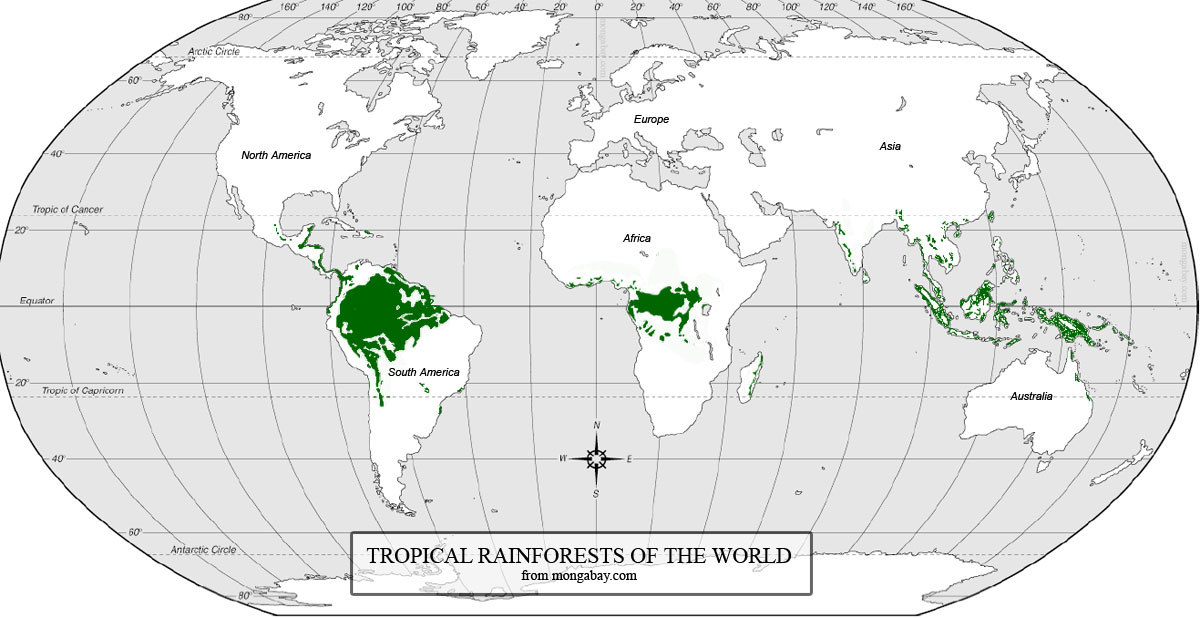The Rainforest
Global location of the tropical rainforest.

The map above could be used as a teaching tool in the introduction to the rainforest. Pupils could be asked to identify the locations of the rainforests across the world and to give possible explanations for this.
The rainforests lie in the tropical regions of the world, these areas lie between the Tropic of Capricorn and the Tropic of Cancer. The location of the rainforest on the equator is essential as the sunlight it receives is essential energy source in the process of photosynthesis. This light source is also responsible for the temperature within the rainforest throughout the year, with typical temperatures between 22-33C. This may vary with elevation where temperatures may be slightly cooler.
The layers of the Rainforest
The tropical rainforest is made up of four layers.

Emergent Layer: The emergent layer contains giant trees which stand above the canopy layer. These trees receive the greatest amount of sunlight, low humidity and strong winds.
Canopy Layer: These trees provide a continuous canopy around 60 - 90 feet from the ground, this is partly due to the branches which are often densely covered in plants. 90% of the organisms which live in the rain forest can be found in the canopy layer.
Understory: This section of the rainforest only receives 2-15% of sunlight which fall on the canopy. It is relatively dark and home to many young trees.
Forest Floor: This layer receives less than 2% of sunlight as a result very little grows here apart from plants which have adapted to receiving very little light. Fallen leaves and vegetation cover the ground and quickly decompose.
Nutrients of the Rainforest
Most rainforest soils have poor nutrients this is due to millions of years of weathering and torrential rains which have caused the nutrients to become washed out of the soil. As a result of this most of the avaliable nutrients withing the rainforest are found in living plants and animals, when a tree dies in the rainforest organisms will absord the nutrients before they become washed away.
Human Impact on the Rainforest
It is a well known fact that large areas of the rainforest are being felled and deforestation is a major problem facing us today.
Here are some causes of deforestation;
- Corruption
- Unrestricted logging
- Increased road networks
- Expansion of agriculture
- Population Growth
Impacts
When rainforests are cleared we lose much more than just trees. Biodiversity of the area is effected greatly. A number of species are dependent on the rainforest for their survival, as their habitat is located there. These species will be forced to either adapt and live in a much smaller area or to won't survive. It is estimated that one species becomes lost every half an hour as a result of deforestation of the rainforest.
The rainforest provides food, fuels, timbre, medicines and fruits and the loss of these products through deforestation is a real issue. There is also concern for the loss of resources which are yet to be discovered especially medicines as almost a quarter of prescription medication in America is derived from tropical rainforest plants and 2000 rainforest plants have been identified by the US National Cancer Institute as having anti cancer properties.
The rainforest has a huge impact on the environment. The removal of the trees means that the soil will lose the primary source of nutrients and rain water will be able to reach the forest floor, washing out any possible nutrients. The removal of trees would increase run off which can cause flooding downstream. This occurred in Venezuela when unseasonable floods were caused by deforestation in December 1999, up to 30 000 people lost their lives and 400 000 were made homeless.
In regards to climate it can be changed on both an local and regional scale, possibly even global depending on the size of the clearance. At a local scale the albedo of the area will be affected as the dark green of the canopy is removed and replaced by lighter shades. The solar radiation will be able to reach the surface much more easily. The soil temperature will fluctuate as a result, this could be harmful for agriculture as it increases the possibility of nutrient leaking within the soil. On a regional scale deforestation may change surface temperatures and also regional air circulation.
Links:
http://www.mbgnet.net/sets/rforest/explore/layers.htm
http://rainforests.mongabay.com/0201.htm







